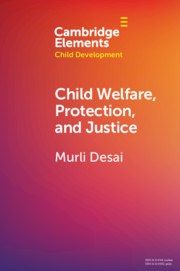Element contents
Child Welfare, Protection, and Justice
Published online by Cambridge University Press: 21 January 2021
Summary
Keywords
- Type
- Element
- Information
- Series: Elements in Child DevelopmentOnline ISBN: 9781108963787Publisher: Cambridge University PressPrint publication: 18 February 2021
References
- 13
- Cited by



